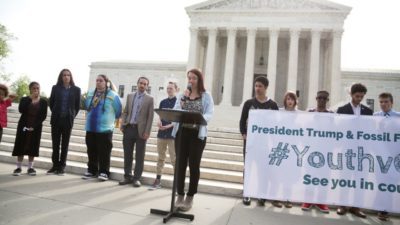Standing Doctrine
Barrett on Standing & Judicial Deference
Her mentor was Scalia, but her style is more like Souter.
With the help of my research assistant, I’ve collected cases by Judge Barrett dealing with standing issues and deference to administrative agencies. Both topics are very relevant to the environment.al crisis. You really can’t draw firm conclusions about her views on these doctrines, but you can draw conclusions about her style. She sticks close to …
Continue reading “Barrett on Standing & Judicial Deference”
CONTINUE READINGJuliana and the Future of Climate Litigation
Asking judges to pass judgment on all U.S. energy policy was a bridge too far.
The Ninth Circuit threw out the Juliana litigation this morning. The two judges in the majority basically said, legalistic language, that you can’t get the Green New Deal by court order. It was wrong for the Supreme Court to step in at the last minute to put the trial on hold, rather than giving the …
Continue reading “Juliana and the Future of Climate Litigation”
CONTINUE READINGStanding and the Juliana v. United States Plaintiffs
Sympathetic Plaintiffs Also Help Legally
It’s not news that the 21 children (some now adults) who are suing the United States for the right to a safe and stable climate are sympathetic and telegenic. They are the primary reason Juliana v. United States has garnered so much attention, including a lengthy, highly positive segment on 60 Minutes. But the Juliana …
Continue reading “Standing and the Juliana v. United States Plaintiffs”
CONTINUE READINGThe Clean Power Plan: Obama’s Easy Mandate
States Complaining About the CPP Are On Pace to Hit Emissions Targets
Back around the turn of the 20th century, New York’s Republican machine was run by Senator Thomas Platt, whose ability to bridge factional gaps gave him the title of “The Easy Boss.” Even though President Obama has attempted the same thing, he will have no such luck. Witness, for example, the states — virtually all …
Continue reading “The Clean Power Plan: Obama’s Easy Mandate”
CONTINUE READINGTakings, Standing, and Those Nasty Neighbors
Most lawyers reading this page are familiar with Nollan v. Calif. Coastal Comm’n, the 1987 Supreme Court case holding that exactions in exchange for land use permits must show an “essential nexus” between the purported harm generated by the permit and aims of the exaction. (More precisely, Nollan gave heightened scrutiny to finding that nexus.). …
Continue reading “Takings, Standing, and Those Nasty Neighbors”
CONTINUE READINGStanding Doctrine Undercuts Industry Challenges – A “Man Bites Dog” Story
According to an old saying, “dog bites man” isn’t newsworthy, but “man bites dog” is worth a headline. Similarly, it’s not especially newsworthy when standing doctrine is used to toss environmentalists out of court. It’s much more so when it’s used against industry. Yet in two recent cases, that’s exactly what the D.C. Circuit was …
Continue reading “Standing Doctrine Undercuts Industry Challenges – A “Man Bites Dog” Story”
CONTINUE READINGThe Last Standing Article You’ll Ever Have to Read
Using the Supreme Court’s ruling on public nuisance law and climate change as an example, the essay argues that standing doctrine has become so incoherent and manipulable that it has lost any real function.
CONTINUE READINGThe Mystery of Sierra Club v. Morton
Sierra Club v. Morton is rightfully viewed as one of the most significant environmental decisions in Supreme Court history. Although it hardly constituted a crimped or anti-environmental decision, it did go a long way to putting the brakes on environmental standing by ruling that the Sierra Club did not have the corporate standing to …
Continue reading “The Mystery of Sierra Club v. Morton”
CONTINUE READINGThe SG Brief in Connecticut v. AEP: WORSE than you think
Okay, so it’s bad enough that the Obama Administration has decided to unilaterally disarm itself in the struggle against climate change. For you law geeks out there (and you know who you are), the SG has gone even further to make these suits impossible in the future. It does this by arguing that the state attorneys …
Continue reading “The SG Brief in Connecticut v. AEP: WORSE than you think”
CONTINUE READINGEnvironmental Property Rights (Part IV)
Environmental property rights, such as tradable permits, conservation trusts, and the public trust doctrine, can change the constitutional landscape of environmental law.
CONTINUE READING






